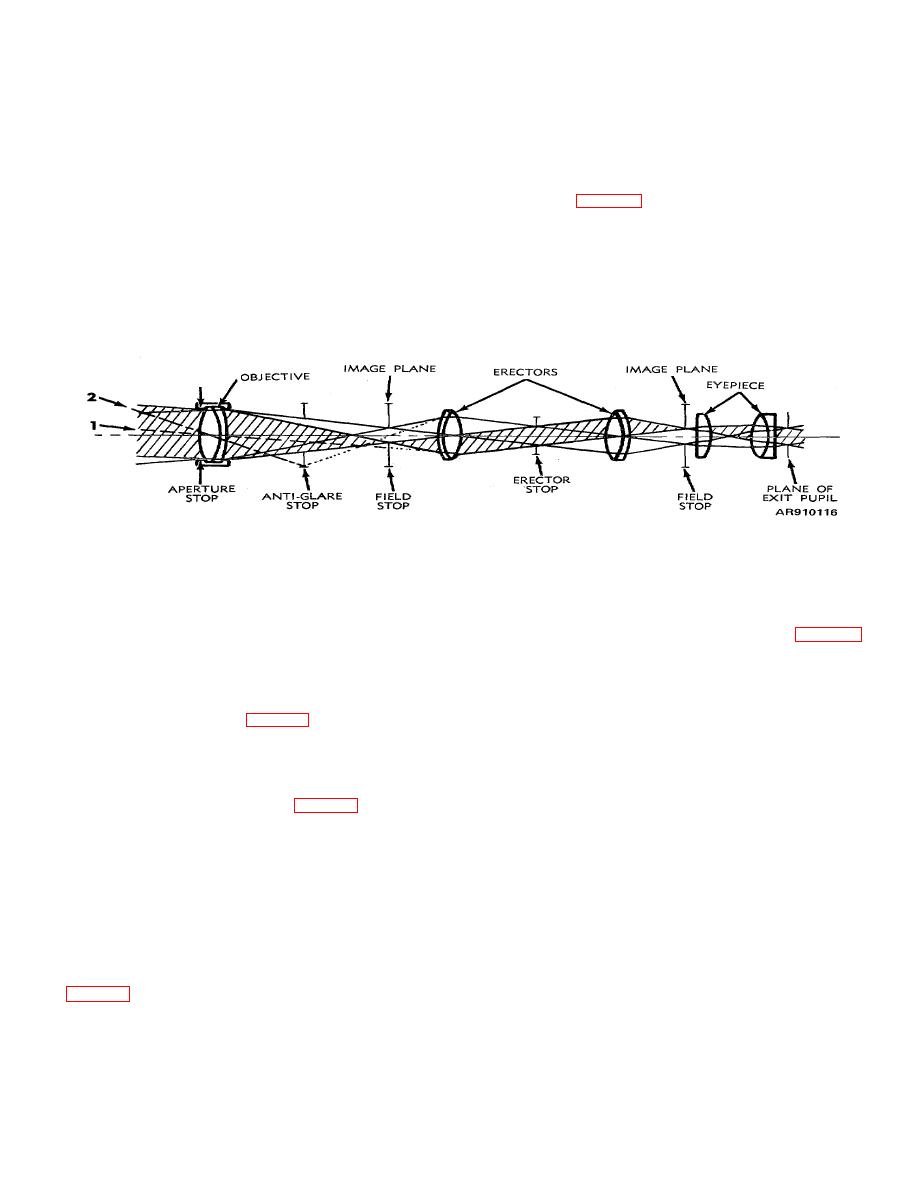 |
|||
|
|
|||
|
|
|||
| ||||||||||
|
|
 TM 9-258
or ghost images caused by internal reflections from
4-10. Diaphragms or Stops.
curved lens surfaces.
a. General. Diaphragms are rings of opaque
b. Antiglare Stops.
material placed in an optical system so that light passes
(1) Antiglare stops improve contrast by
through their centers. As their apertures limit the field of
preventing rays exterior to the field from bouncing off the
view they are sometimes called field stops. When
interior of the instrument and fogging the field or causing
placed around the edges of lenses, they prevent rays
glare ray (2, fig 4-26). Nonreflecting paint and baffle
from passing through the margins of the lenses and
finish on inner wall of the tube likewise eliminate most of
causing aberrations.
When placed between the
this undesired light. Light from a billiant source may still
objective and the erecting system or between the
be reflected off a dark wall and cause serious trouble
erecting system and the eyepiece, or in both or these
especially with a glass reticle. This is particularly true in
positions or between parts of the erecting system,
wide-angle telescopes and antiaircraft instruments which
they eliminate marginal rays which would otherwise
may be pointed toward the sun.
cause glare and haze by reflecting from the inside walls,
Figure 4-26. Diaphragm (stop) location.
(2) In straight-tube telescopes, the stops are
image of the first at that point so that slight inaccuracy in
merely washers or disks with a hole in the center. The
size or positioning will not conflict with the sharply
prism shelf in a binocular is designed to act as a stop.
defined image of the first.
d. Aperture Stops. In telescopes, this stop (fig 4-26)
The groove in the face, the rounded corners, and
flattened apex of Porro prisms are designed to function
usually is the objective lens cell or retaining ring as there
as stops.
is no reason for reducing the size of the aperture of the
(3) Antiglare stops usually are located between
single compound objective lens usually used in such an
the objective and the erectors or wherever an image of
instrument (as contrasted with the need for such stops in
the aperture stop is formed (fig 4-26). They are known
wide-angle camera lenses to reduce aberrations). A
as erector stops if they are located between erectors.
stop in close proximity to such a single compound lens
Such stops provide balance illumination by limiting the
objective would only reduce the illumination and exit pupil
rays from the center of the field to the same area as
size (the same as using a smaller lens) without reduction
those from the edge of the field.
in aberrations from the lens area used. In a complex
c. Field Stops. The field stop (fig 4-26) limits the
objective (two or more separate lenses), however, a stop
field to that area which is fully illuminated and sharply
located between the lenses may reduce aberrations.
focused by eliminating the peripheral region of poor
Also, in a complex eyepiece of several elements, a stop
imagery (caused by aberrations) and also prevents the
between the elements may serve to reduce aberrations.
e. Field Effects. All stops, excepting an objective
observer from viewing the inside of the instrument. It is
located in an image plane providing a sharply defined
aperture stop, can be considered to limit the field since
limit to the field. It is designed to admit all the light or
they may prevent rays exterior to the field from reaching
limiting rays needed by the next element whether
the eye. In designing a system, however, this field limit
erectors or eyepiece. The field stop also may function as
is determined from the apparent field of the eyepiece so
an antiglare stop preventing rays exterior to the field from
that in the final analysis the true field of the instrument
being reflected off inner surfaces back into the field (ray
must be governed by the eyepiece.
1, fig 4-26). If a field stop is used in each image plane,
the second such stop is slightly larger than the
4-28
|
|
Privacy Statement - Press Release - Copyright Information. - Contact Us |